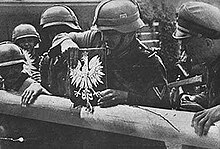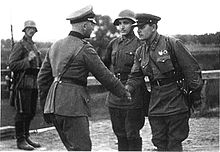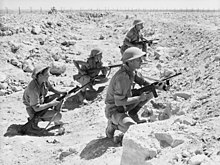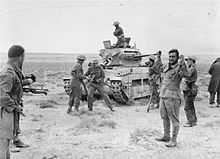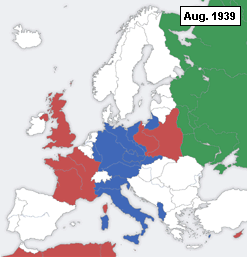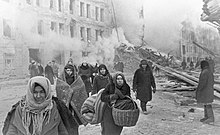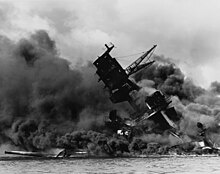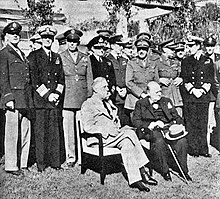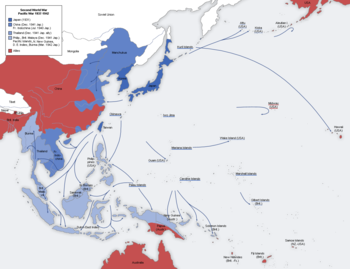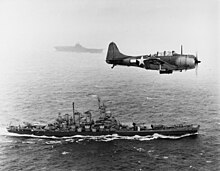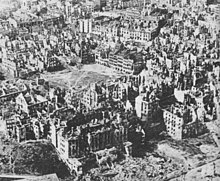War breaks out in Europe (1939–40)
On 1 September 1939, Germany invaded Poland under the false pretext that the Poles had carried out a series of sabotage operations against German targets near the border.[60] Two days later, on 3 September, after a British ultimatum to Germany to cease military operations was ignored, Britain and France, followed by the fully independent Dominions[61] of the British Commonwealth[62]—Australia (3 September), Canada (10 September), New Zealand (3 September), and South Africa (6 September)—declared war on Germany. However, initially the alliance provided limited direct military support to Poland, consisting of a cautious, half-hearted French probe into the Saarland.[63] The Western Allies also began a naval blockade of Germany, which aimed to damage the countrys economy and war effort.[64] Germany responded by ordering U-boat warfare against Allied merchant and warships, which was to later escalate into the Battle of the Atlantic.
On 17 September 1939, after signing a cease-fire with Japan, the Soviets invaded Poland from the east.[65] The Polish army was defeated and Warsaw surrendered to the Germans on 27 September, with final pockets of resistance surrendering on 6 October. Polands territory was divided between Germany and the Soviet Union, with Lithuania and Slovakia also receiving small shares. After the defeat of Polands armed forces, the Polish resistance established an Underground State and a partisan Home Army.[66] About 100,000 Polish military personnel were evacuated to Romania and the Baltic countries; many of these soldiers later fought against the Germans in other theatres of the war.[67] Polands Enigma codebreakers were also evacuated to France.[68]
On 6 October Hitler made a public peace overture to Britain and France, but said that the future of Poland was to be determined exclusively by Germany and the Soviet Union. Chamberlain rejected this on 12 October, saying "Past experience has shown that no reliance can be placed upon the promises of the present German Government."[59] After this rejection Hitler ordered an immediate offensive against France,[69] but bad weather forced repeated postponements until the spring of 1940.[70][71][72]
After signing the German–Soviet Treaty of Friendship, Cooperation and Demarcation, the Soviet Union forced the Baltic countries—Estonia, Latvia and Lithuania—to allow it to station Soviet troops in their countries under pacts of "mutual assistance".[73][74][75] Finland rejected territorial demands, prompting a Soviet invasion in November 1939.[76] The resulting Winter War ended in March 1940 with Finnish concessions.[77] Britain and France, treating the Soviet attack on Finland as tantamount to its entering the war on the side of the Germans, responded to the Soviet invasion by supporting the USSRs expulsion from the League of Nations.[75]
In June 1940, the Soviet Union forcibly annexed Estonia, Latvia and Lithuania,[74] and the disputed Romanian regions of Bessarabia, Northern Bukovina and Hertza. Meanwhile, Nazi-Soviet political rapprochement and economic co-operation[78][79] gradually stalled,[80][81] and both states began preparations for war.[82]
Western Europe (1940–41)
In April 1940, Germany invaded Denmark and Norway to protect shipments of iron ore from Sweden, which the Allies were attempting to cut off by unilaterally mining neutral Norwegian waters.[83] Denmark capitulated after a few hours, and despite Allied support, during which the important harbour of Narvik temporarily was recaptured from the Germans, Norway was conquered within two months.[84] British discontent over the Norwegian campaign led to the replacement of the British Prime Minister, Neville Chamberlain, with Winston Churchill on 10 May 1940.[85]
Germany launched an offensive against France and, adhering to the Manstein Plan also attacked the neutral nations of Belgium, the Netherlands, and Luxembourg on 10 May 1940.[86] That same day British forces landed in Iceland and the Faroes to preempt a possible German invasion of the islands.[87] The U.S. in close co-operation with the Danish envoy to Washington D.C., agreed to protect Greenland, laying the political framework for the formal establishment of bases in April 1941. The Netherlands and Belgium were overrun using blitzkrieg tactics in a few days and weeks, respectively.[88] The French-fortified Maginot Line and the main body the Allied forces which had moved into Belgium were circumvented by a flanking movement through the thickly wooded Ardennes region,[89] mistakenly perceived by Allied planners as an impenetrable natural barrier against armoured vehicles.[90][91] As a result, the bulk of the Allied armies found themselves trapped in an encirclement and were beaten. The majority were taken prisoner, whilst over 300,000, mostly British and French, were evacuated from the continent at Dunkirk by early June, although abandoning almost all of their equipment.[92]
On 10 June, Italy invaded France, declaring war on both France and the United Kingdom.[93] Paris fell to the Germans on 14 June and eight days later France signed an armistice with Germany and was soon divided into German and Italian occupation zones,[94] and an unoccupied rump state under the Vichy Regime, which, though officially neutral, was generally aligned with Germany. France kept its fleet but the British feared the Germans would seize it, so on 3 July, the British attacked it.[95]
The Battle of Britain[96] began in early July with Luftwaffe attacks on shipping and harbours.[97] On 19 July, Hitler again publicly offered to end the war, saying he had no desire to destroy the British Empire. The United Kingdom rejected this ultimatum.[98] The main German air superiority campaign started in August but failed to defeat RAF Fighter Command, and a proposed invasion was postponed indefinitely on 17 September. The German strategic bombing offensive intensified as night attacks on London and other cities in the Blitz, but largely failed to disrupt the British war effort.[97]
Using newly captured French ports, the German Navy enjoyed success against an over-extended Royal Navy, using U-boats against British shipping in the Atlantic.[99] The British scored a significant victory on 27 May 1941 by sinking the German battleship Bismarck.[100] Perhaps most importantly, during the Battle of Britain the Royal Air Force had successfully resisted the Luftwaffes assault, and the German bombing campaign largely ended in May 1941.[101]
Throughout this period, the neutral United States took measures to assist China and the Western Allies. In November 1939, the American Neutrality Act was amended to allow "cash and carry" purchases by the Allies.[102] In 1940, following the German capture of Paris, the size of the United States Navy was significantly increased. In September, the United States further agreed to a trade of American destroyers for British bases.[103] Still, a large majority of the American public continued to oppose any direct military intervention into the conflict well into 1941.[104]
Although Roosevelt had promised to keep the United States out of the war, he nevertheless took concrete steps to prepare for war. In December 1940 he accused Hitler of planning world conquest and ruled out negotiations as useless, calling for the US to become an "arsenal for democracy" and promoted the passage of Lend-Lease aid to support the British war effort.[98] In January 1941 secret high level staff talks with the British began for the purposes of determining how to defeat Germany should the US enter the war. They decided on a number of offensive policies, including an air offensive, the "early elimination" of Italy, raids, support of resistance groups, and the capture of positions to launch an offensive against Germany.[105]
At the end of September 1940, the Tripartite Pact united Japan, Italy and Germany to formalise the Axis Powers. The Tripartite Pact stipulated that any country, with the exception of the Soviet Union, not in the war which attacked any Axis Power would be forced to go to war against all three.[106] The Axis expanded in November 1940 when Hungary, Slovakia and Romania joined the Tripartite Pact.[107] Romania would make a major contribution (as did Hungary) to the Axis war against the USSR, partially to recapture territory ceded to the USSR, partially to pursue its leader Ion Antonescus desire to combat communism.[108]
Mediterranean (1940–41)
Italy began operations in the Mediterranean, initiating a siege of Malta in June, conquering British Somaliland in August, and making an incursion into British-held Egypt in September 1940. In October 1940, Italy started the Greco-Italian War because of Mussolinis jealousy of Hitlers success but within days was repulsed and pushed back into Albania, where a stalemate soon occurred.[109] The United Kingdom responded to Greek requests for assistance by sending troops to Crete and providing air support to Greece. Hitler decided that when the weather improved he would take action against Greece to assist the Italians and prevent the British from gaining a foothold in the Balkans, to strike against the British naval dominance of the Mediterranean, and to secure his hold on Romanian oil.[110]
In December 1940, British Commonwealth forces began counter-offensives against Italian forces in Egypt and Italian East Africa.[111] The offensive in North Africa was highly successful and by early February 1941 Italy had lost control of eastern Libya and large numbers of Italian troops had been taken prisoner. The Italian Navy also suffered significant defeats, with the Royal Navy putting three Italian battleships out of commission by a carrier attack at Taranto, and neutralising several more warships at the Battle of Cape Matapan.[112]
The Germans soon intervened to assist Italy. Hitler sent German forces to Libya in February, and by the end of March they had launched an offensive which drove back the Commonwealth forces which had been weakened to support Greece.[113] In under a month, Commonwealth forces were pushed back into Egypt with the exception of the besieged port of Tobruk.[114] The Commonwealth attempted to dislodge Axis forces in May and again in June, but failed on both occasions.[115]
By late March 1941, following Bulgarias signing of the Tripartite Pact, the Germans were in position to intervene in Greece. Plans were changed, however, because of developments in neighbouring Yugoslavia. The Yugoslav government had signed the Tripartite Pact on 25 March, only to be overthrown two days later by a British-encouraged coup. Hitler viewed the new regime as hostile and immediately decided to eliminate it. On 6 April Germany simultaneously invaded both Yugoslavia and Greece, making rapid progress and forcing both nations to surrender within the month. The British were driven from the Balkans after Germany conquered the Greek island of Crete by the end of May.[116] Although the Axis victory was swift, bitter partisan warfare subsequently broke out against the Axis occupation of Yugoslavia, which continued until the end of the war.
The Allies did have some successes during this time. In the Middle East, Commonwealth forces first quashed an uprising in Iraq which had been supported by German aircraft from bases within Vichy-controlled Syria,[117] then, with the assistance of the Free French, invaded Syria and Lebanon to prevent further such occurrences.[118]
Axis attack on the USSR (1941)
With the situation in Europe and Asia relatively stable, Germany, Japan, and the Soviet Union made preparations. With the Soviets wary of mounting tensions with Germany and the Japanese planning to take advantage of the European War by seizing resource-rich European possessions in Southeast Asia, the two powers signed the Soviet–Japanese Neutrality Pact in April 1941.[119] By contrast, the Germans were steadily making preparations for an attack on the Soviet Union, massing forces on the Soviet border.[120]
Hitler believed that Britains refusal to end the war was based on the hope that the United States and the Soviet Union would enter the war against Germany sooner or later.[121] He therefore decided to try to strengthen Germanys relations with the Soviets, or failing that, to attack and eliminate them as a factor. In November 1940, negotiations took place to determine if the Soviet Union would join the Tripartite Pact. The Soviets showed some interest, but asked for concessions from Finland, Bulgaria, Turkey, and Japan that Germany considered unacceptable. On 18 December 1940, Hitler issued the directive to prepare for an invasion of the Soviet Union.
On 22 June 1941, Germany, supported by Italy and Romania, invaded the Soviet Union in Operation Barbarossa, with Germany accusing the Soviets of plotting against them. They were joined shortly by Finland and Hungary.[122] The primary targets of this surprise offensive[123] were the Baltic region, Moscow and Ukraine, with the ultimate goal of ending the 1941 campaign near the Arkhangelsk-Astrakhan line, from the Caspian to the White Seas. Hitlers objectives were to eliminate the Soviet Union as a military power, exterminate Communism, generate Lebensraum ("living space")[124] by dispossessing the native population[125] and guarantee access to the strategic resources needed to defeat Germanys remaining rivals.[126]
Although the Red Army was preparing for strategic counter-offensives before the war,[127] Barbarossa forced the Soviet supreme command to adopt a strategic defence. During the summer, the Axis made significant gains into Soviet territory, inflicting immense losses in both personnel and materiel. By the middle of August, however, the German Army High Command decided to suspend the offensive of a considerably depleted Army Group Centre, and to divert the 2nd Panzer Group to reinforce troops advancing towards central Ukraine and Leningrad.[128] The Kiev offensive was overwhelmingly successful, resulting in encirclement and elimination of four Soviet armies, and made further advance into Crimea and industrially developed Eastern Ukraine (the First Battle of Kharkov) possible.[129]
The diversion of three quarters of the Axis troops and the majority of their air forces from France and the central Mediterranean to the Eastern Front[130] prompted Britain to reconsider its grand strategy.[131] In July, the UK and the Soviet Union formed a military alliance against Germany[132] The British and Soviets invaded Iran to secure the Persian Corridor and Irans oil fields.[133] In August, the United Kingdom and the United States jointly issued the Atlantic Charter.[134]
By October Axis operational objectives in Ukraine and the Baltic region were achieved, with only the sieges of Leningrad[135] and Sevastopol continuing.[136] A major offensive against Moscow was renewed; after two months of fierce battles in increasingly harsh weather the German army almost reached the outer suburbs of Moscow, where the exhausted troops[137] were forced to suspend their offensive.[138] Large territorial gains were made by Axis forces, but their campaign had failed to achieve its main objectives: two key cities remained in Soviet hands, the Soviet capability to resist was not broken, and the Soviet Union retained a considerable part of its military potential. The blitzkrieg phase of the war in Europe had ended.[139]
By early December, freshly mobilised reserves[140] allowed the Soviets to achieve numerical parity with Axis troops.[141] This, as well as intelligence data which established that a minimal number of Soviet troops in the East would be sufficient to deter any attack by the Japanese Kwantung Army,[142] allowed the Soviets to begin a massive counter-offensive that started on 5 December all along the front and pushed German troops 100–250 kilometres (62–155 mi) west.[143]
War breaks out in the Pacific (1941)
In 1939 the United States had renounced its trade treaty with Japan and beginning with an aviation gasoline ban in July 1940 Japan had become subject to increasing economic pressure.[98] During this time, Japan launched its first attack against Changsha, a strategically important Chinese city, but was repulsed by late September.[144] Despite several offensives by both sides, the war between China and Japan was stalemated by 1940. To increase pressure on China by blocking supply routes, and to better position Japanese forces in the event of a war with the Western powers, Japan invaded and occupied northern Indochina.[145] Afterwards, the United States embargoed iron, steel and mechanical parts against Japan.[146] Other sanctions soon followed.
In August of that year, Chinese communists launched an offensive in Central China; in retaliation, Japan instituted harsh measures in occupied areas to reduce human and material resources for the communists.[147] Continued antipathy between Chinese communist and nationalist forces culminated in armed clashes in January 1941, effectively ending their co-operation.[148] In March, the Japanese 11th army attacked the headquarters of the Chinese 19th army but was repulsed during Battle of Shanggao.[149] In September, Japan attempted to take the city of Changsha again and clashed with Chinese nationalist forces.[150]
German successes in Europe encouraged Japan to increase pressure on European governments in Southeast Asia. The Dutch government agreed to provide Japan some oil supplies from the Dutch East Indies, but negotiations for additional access to their resources ended in failure in June 1941.[151] In July 1941 Japan sent troops to southern Indochina, thus threatening British and Dutch possessions in the Far East. The United States, United Kingdom and other Western governments reacted to this move with a freeze on Japanese assets and a total oil embargo.[152][153]
Since early 1941 the United States and Japan had been engaged in negotiations in an attempt to improve their strained relations and end the war in China. During these negotiations Japan advanced a number of proposals which were dismissed by the Americans as inadequate.[154] At the same time the US, Britain, and the Netherlands engaged in secret discussions for the joint defence of their territories, in the event of a Japanese attack against any of them.[155] Roosevelt reinforced the Philippines (an American protectorate scheduled for independence in 1946) and warned Japan that the US would react to Japanese attacks against any "neighboring countries".[155]
Frustrated at the lack of progress and feeling the pinch of the American-British-Dutch sanctions, Japan prepared for war. On 20 November it presented an interim proposal as its final offer. It called for the end of American aid to China and to supply oil and other resources to Japan. In exchange they promised not to launch any attacks in Southeast Asia and to withdraw their forces from their threatening positions in southern Indochina.[154] The American counter-proposal of 26 November required that Japan evacuate all of China without conditions and conclude non-aggression pacts with all Pacific powers.[156] That meant Japan was essentially forced to choose between abandoning its ambitions in China, or seizing the natural resources it needed in the Dutch East Indies by force;[157] the Japanese military did not consider the former an option, and many officers considered the oil embargo an unspoken declaration of war.[158]
Japan planned to rapidly seize European colonies in Asia to create a large defensive perimeter stretching into the Central Pacific; the Japanese would then be free to exploit the resources of Southeast Asia while exhausting the over-stretched Allies by fighting a defensive war.[159] To prevent American intervention while securing the perimeter it was further planned to neutralise the United States Pacific Fleet and the American military presence in the Philippines from the outset.[160] On 7 December 1941 (8 December in Asian time zones), Japan attacked British and American holdings with near-simultaneous offensives against Southeast Asia and the Central Pacific.[161] These included an attack on the American fleet at Pearl Harbor, the Philippines, landings in Thailand and Malaya[161] and the battle of Hong Kong.
These attacks led the United States, Britain, China, Australia and several other states to formally declare war on Japan, whereas the Soviet Union, being heavily involved in large-scale hostilities with European Axis countries, maintained its neutrality agreement with Japan.[162] Germany, followed by the other Axis states, declared war on the United States[163] in solidarity with Japan, citing as justification the American attacks on German war vessels that had been ordered by Roosevelt.[122][164]
Axis advance stalls (1942–43)
In January 1942, the Big Four (the United States, Britain, Soviet Union, China) and 22 smaller or exiled governments issued the Declaration by United Nations, thereby affirming the Atlantic Charter,[165] and agreeing to not to sign a separate peace with the Axis powers.
During 1942, Allied officials debated on the appropriate grand strategy to pursue. All agreed that defeating Germany was the primary objective. The Americans favoured a straightforward, large-scale attack on Germany through France. The Soviets were also demanding a second front. The British, on the other hand, argued that military operations should target peripheral areas to wear out German strength, lead to increasing demoralisation, and bolster resistance forces. Germany itself would be subject to a heavy bombing campaign. An offensive against Germany would then be launched primarily by Allied armour without using large-scale armies.[166] Eventually, the British persuaded the Americans that a landing in France was infeasible in 1942 and they should instead focus on driving the Axis out of North Africa.[167]
At the Casablanca Conference in early 1943, the Allies reiterated the statements issued in the 1942 Declaration by the United Nations, and demanded the unconditional surrender of their enemies. The British and Americans agreed to continue to press the initiative in the Mediterranean by invading Sicily to fully secure the Mediterranean supply routes.[168] Although the British argued for further operations in the Balkans to bring Turkey into the war, in May 1943, the Americans extracted a British commitment to limit Allied operations in the Mediterranean to an invasion of the Italian mainland and to invade France in 1944.[169]
Pacific (1942–43)
By the end of April 1942, Japan and its ally Thailand had almost fully conquered Burma, Malaya, the Dutch East Indies, Singapore, and Rabaul, inflicting severe losses on Allied troops and taking a large number of prisoners.[170] Despite stubborn resistance by Filipino and US forces, the Philippine Commonwealth was eventually captured in May 1942, forcing its government into exile.[171] On 16 April, in Burma, 7,000 British soldiers were encircled by the Japanese 33rd Division during the Battle of Yenangyaung and rescued by the Chinese 38th Division.[172] Japanese forces also achieved naval victories in the South China Sea, Java Sea and Indian Ocean,[173] and bombed the Allied naval base at Darwin, Australia. In January 1942, the only Allied success against Japan was a Chinese victory at Changsha.[174] These easy victories over unprepared US and European opponents left Japan overconfident, as well as overextended.[175]
In early May 1942, Japan initiated operations to capture Port Moresby by amphibious assault and thus sever communications and supply lines between the United States and Australia. The planned invasion was thwarted when an Allied task force centered on two American fleet carriers fought Japanese naval forces to a draw in the Battle of the Coral Sea.[176] Japans next plan, motivated by the earlier Doolittle Raid, was to seize Midway Atoll and lure American carriers into battle to be eliminated; as a diversion, Japan would also send forces to occupy the Aleutian Islands in Alaska.[177] In early June, Japan put its operations into action but the Americans, having broken Japanese naval codes in late May, were fully aware of the plans and force dispositions and used this knowledge to achieve a decisive victory at Midway over the Imperial Japanese Navy.[178]
With its capacity for aggressive action greatly diminished as a result of the Midway battle, Japan chose to focus on a belated attempt to capture Port Moresby by an overland campaign in the Territory of Papua.[179] The Americans planned a counter-attack against Japanese positions in the southern Solomon Islands, primarily Guadalcanal, as a first step towards capturing Rabaul, the main Japanese base in Southeast Asia.[180]
Both plans started in July, but by mid-September, the Battle for Guadalcanal took priority for the Japanese, and troops in New Guinea were ordered to withdraw from the Port Moresby area to the northern part of the island, where they faced Australian and United States troops in the Battle of Buna-Gona.[181] Guadalcanal soon became a focal point for both sides with heavy commitments of troops and ships in the battle for Guadalcanal. By the start of 1943, the Japanese were defeated on the island and withdrew their troops.[182] In Burma, Commonwealth forces mounted two operations. The first, an offensive into the Arakan region in late 1942, went disastrously, forcing a retreat back to India by May 1943.[183] The second was the insertion of irregular forces behind Japanese front-lines in February which, by the end of April, had achieved mixed results.[184]
Eastern Front (1942–43)
Despite considerable losses, in early 1942 Germany and its allies stopped a major Soviet offensive in central and southern Russia, keeping most territorial gains they had achieved during the previous year.[185] In May the Germans defeated Soviet offensives in the Kerch Peninsula and at Kharkiv,[186] and then launched their main summer offensive against southern Russia in June 1942, to seize the oil fields of the Caucasus and occupy Kuban steppe, while maintaining positions on the northern and central areas of the front. The Germans split Army Group South into two groups: Army Group A advanced to the lower Don River and struck south-east to the Caucasus, while Army Group B headed towards the Volga River. The Soviets decided to make their stand at Stalingrad on the Volga.[187]
By mid-November, the Germans had nearly taken Stalingrad in bitter street fighting when the Soviets began their second winter counter-offensive, starting with an encirclement of German forces at Stalingrad[188] and an assault on the Rzhev salient near Moscow, though the latter failed disastrously.[189] By early February 1943, the German Army had taken tremendous losses; German troops at Stalingrad had been forced to surrender,[190] and the front-line had been pushed back beyond its position before the summer offensive. In mid-February, after the Soviet push had tapered off, the Germans launched another attack on Kharkiv, creating a salient in their front line around the Russian city of Kursk.[191]
Western Europe/Atlantic & Mediterranean (1942–43)
Exploiting poor American naval command decisions, the German navy ravaged Allied shipping off the American Atlantic coast.[192] By November 1941, Commonwealth forces had launched a counter-offensive, Operation Crusader, in North Africa, and reclaimed all the gains the Germans and Italians had made.[193] In North Africa, the Germans launched an offensive in January, pushing the British back to positions at the Gazala Line by early February,[194] followed by a temporary lull in combat which Germany used to prepare for their upcoming offensives.[195] Concerns the Japanese might use bases in Vichy-held Madagascar caused the British to invade the island in early May 1942.[196] An Axis offensive in Libya forced an Allied retreat deep inside Egypt until Axis forces were stopped at El Alamein.[197] On the Continent, raids of Allied commandos on strategic targets, culminating in the disastrous Dieppe Raid,[198] demonstrated the Western Allies inability to launch an invasion of continental Europe without much better preparation, equipment, and operational security.[199]
In August 1942, the Allies succeeded in repelling a second attack against El Alamein[200] and, at a high cost, managed to deliver desperately needed supplies to the besieged Malta.[201] A few months later, the Allies commenced an attack of their own in Egypt, dislodging the Axis forces and beginning a drive west across Libya.[202] This attack was followed up shortly after by Anglo-American landings in French North Africa, which resulted in the region joining the Allies.[203] Hitler responded to the French colonys defection by ordering the occupation of Vichy France;[203] although Vichy forces did not resist this violation of the armistice, they managed to scuttle their fleet to prevent its capture by German forces.[204] The now pincered Axis forces in Africa withdrew into Tunisia, which was conquered by the Allies in May 1943.[205]
In early 1943 the British and Americans began the Combined Bomber Offensive, a strategic bombing campaign against Germany. The goals were to disrupt the German war economy, reduce German morale, and "de-house" the civilian population.[206]
Allies gain momentum (1943–44)
After the Guadalcanal Campaign, the Allies initiated several operations against Japan in the Pacific. In May 1943, Canadian and U.S. forces were sent to eliminate Japanese forces from the Aleutians.[207] Soon after, the U.S. with support from Australian and New Zealand forces began major operations to isolate Rabaul by capturing surrounding islands, and to breach the Japanese Central Pacific perimeter at the Gilbert and Marshall Islands.[208] By the end of March 1944, the Allies had completed both of these objectives, and additionally neutralised the major Japanese base at Truk in the Caroline Islands. In April, the Allies launched an operation to retake Western New Guinea.[209]
In the Soviet Union, both the Germans and the Soviets spent the spring and early summer of 1943 preparing for large offensives in central Russia. On 4 July 1943, Germany attacked Soviet forces around the Kursk Bulge. Within a week, German forces had exhausted themselves against the Soviets deeply echeloned and well-constructed defences[210] and, for the first time in the war, Hitler cancelled the operation before it had achieved tactical or operational success.[211] This decision was partially affected by the Western Allies invasion of Sicily launched on 9 July which, combined with previous Italian failures, resulted in the ousting and arrest of Mussolini later that month.[212] Also, in July 1943 the British firebombed Hamburg killing over 40,000 people.
On 12 July 1943, the Soviets launched their own counter-offensives, thereby dispelling any chance of German victory or even stalemate in the east. The Soviet victory at Kursk marked the end of German superiority,[213] giving the Soviet Union the initiative on the Eastern Front.[214][215] The Germans tried to stabilise their eastern front along the hastily fortified Panther-Wotan line, but the Soviets broke through it at Smolensk and by the Lower Dnieper Offensives.[216]
On 3 September 1943, the Western Allies invaded the Italian mainland, following Italys armistice with the Allies.[217] Germany responded by disarming Italian forces, seizing military control of Italian areas,[218] and creating a series of defensive lines.[219] German special forces then rescued Mussolini, who then soon established a new client state in German occupied Italy named the Italian Social Republic,[220] causing an Italian civil war. The Western Allies fought through several lines until reaching the main German defensive line in mid-November.[221]
German operations in the Atlantic also suffered. By May 1943, as Allied counter-measures became increasingly effective, the resulting sizeable German submarine losses forced a temporary halt of the German Atlantic naval campaign.[222] In November 1943, Franklin D. Roosevelt and Winston Churchill met with Chiang Kai-shek in Cairo and then with Joseph Stalin in Tehran.[223] The former conference determined the post-war return of Japanese territory,[224] while the latter included agreement that the Western Allies would invade Europe in 1944 and that the Soviet Union would declare war on Japan within three months of Germanys defeat.[225]
From November 1943, during the seven-week Battle of Changde, the Chinese forced Japan to fight a costly war of attrition, while awaiting Allied relief.[226][227][228] In January 1944, the Allies launched a series of attacks in Italy against the line at Monte Cassino and tried to outflank it with landings at Anzio.[229] By the end of January, a major Soviet offensive expelled German forces from the Leningrad region,[230] ending the longest and most lethal siege in history.
The following Soviet offensive was halted on the pre-war Estonian border by the German Army Group North aided by Estonians hoping to re-establish national independence. This delay slowed subsequent Soviet operations in the Baltic Sea region.[231] By late May 1944, the Soviets had liberated Crimea, largely expelled Axis forces from Ukraine, and made incursions into Romania, which were repulsed by the Axis troops.[232] The Allied offensives in Italy had succeeded and, at the expense of allowing several German divisions to retreat, on 4 June, Rome was captured.[233]
The Allies had mixed success in mainland Asia. In March 1944, the Japanese launched the first of two invasions, an operation against British positions in Assam, India,[234] and soon besieged Commonwealth positions at Imphal and Kohima.[235] In May 1944, British forces mounted a counter-offensive that drove Japanese troops back to Burma,[235] and Chinese forces that had invaded northern Burma in late 1943 besieged Japanese troops in Myitkyina.[236] The second Japanese invasion of China aimed to destroy Chinas main fighting forces, secure railways between Japanese-held territory and capture Allied airfields.[237] By June, the Japanese had conquered the province of Henan and begun a new attack on Changsha in the Hunan province.[238]
Allies close in (1944)
On 6 June 1944 (known as D-Day), after three years of Soviet pressure,[239] the Western Allies invaded northern France. After reassigning several Allied divisions from Italy, they also attacked southern France.[240] These landings were successful, and led to the defeat of the German Army units in France. Paris was liberated by the local resistance assisted by the Free French Forces, both led by General Charles de Gaulle, on 25 August[241] and the Western Allies continued to push back German forces in western Europe during the latter part of the year. An attempt to advance into northern Germany spearheaded by a major airborne operation in the Netherlands failed.[242] After that, the Western Allies slowly pushed into Germany, but failed to cross the Rur river in a large offensive. In Italy, Allied advance also slowed due to the last major German defensive line.[243]
On 22 June, the Soviets launched a strategic offensive in Belarus ("Operation Bagration") that destroyed the German Army Group Centre almost completely.[244] Soon after that another Soviet strategic offensive forced German troops from Western Ukraine and Eastern Poland. The Soviet advance prompted resistance forces in Poland to initiate several uprisings against the German occupation. However, the largest of these in Warsaw where German soldiers massacred 200,000 civilians and a national uprising in Slovakia did not receive Soviet support and were subsequently suppressed by the Germans.[245] The Red Armys strategic offensive in eastern Romania cut off and destroyed the considerable German troops there and triggered a successful coup détat in Romania and in Bulgaria, followed by those countries shift to the Allied side.[246]
In September 1944, Soviet troops advanced into Yugoslavia and forced the rapid withdrawal of German Army Groups E and F in Greece, Albania and Yugoslavia to rescue them from being cut off.[247] By this point, the Communist-led Partisans under Marshal Josip Broz Tito, who had led an increasingly successful guerrilla campaign against the occupation since 1941, controlled much of the territory of Yugoslavia and engaged in delaying efforts against German forces further south. In northern Serbia, the Red Army, with limited support from Bulgarian forces, assisted the Partisans in a joint liberation of the capital city of Belgrade on 20 October. A few days later, the Soviets launched a massive assault against German-occupied Hungary that lasted until the fall of Budapest in February 1945.[248] Unlike impressive Soviet victories in the Balkans, bitter Finnish resistance to the Soviet offensive in the Karelian Isthmus denied the Soviets occupation of Finland and led to a Soviet-Finnish armistice on relatively mild conditions,[249][250] although Finland later shifted to the Allied side.
By the start of July 1944, Commonwealth forces in Southeast Asia had repelled the Japanese sieges in Assam, pushing the Japanese back to the Chindwin River[251] while the Chinese captured Myitkyina. In China, the Japanese had more successes, having finally captured Changsha in mid-June and the city of Hengyang by early August.[252] Soon after, they invaded the province of Guangxi, winning major engagements against Chinese forces at Guilin and Liuzhou by the end of November[253] and successfully linking up their forces in China and Indochina by mid-December.[254]
In the Pacific, US forces continued to press back the Japanese perimeter. In mid-June 1944, they began their offensive against the Mariana and Palau islands, and decisively defeated Japanese forces in the Battle of the Philippine Sea. These defeats led to the resignation of the Japanese Prime Minister, Hideki Tojo, and provided the United States with air bases to launch intensive heavy bomber attacks on the Japanese home islands. In late October, American forces invaded the Filipino island of Leyte; soon after, Allied naval forces scored another large victory in the Battle of Leyte Gulf, one of the largest naval battles in history.[255]
Axis collapse, Allied victory (1944–45)
On 16 December 1944, Germany made a last attempt on the Western Front by using most of its remaining reserves to launch a massive counter-offensive in the Ardennes to split the Western Allies, encircle large portions of Western Allied troops and capture their primary supply port at Antwerp to prompt a political settlement.[256] By January, the offensive had been repulsed with no strategic objectives fulfilled.[256] In Italy, the Western Allies remained stalemated at the German defensive line. In mid-January 1945, the Soviets and Poles attacked in Poland, pushing from the Vistula to the Oder river in Germany, and overran East Prussia.[257] On 4 February, US, British, and Soviet leaders met for the Yalta Conference. They agreed on the occupation of post-war Germany, and on when the Soviet Union would join the war against Japan.[258]
In February, the Soviets entered Silesia and Pomerania, while Western Allies entered western Germany and closed to the Rhine river. By March, the Western Allies crossed the Rhine north and south of the Ruhr, encircling the German Army Group B,[259] while the Soviets advanced to Vienna. In early April, the Western Allies finally pushed forward in Italy and swept across western Germany, while Soviet and Polish forces stormed Berlin in late April. American and Soviet forces joined on Elbe river on 25 April. On 30 April 1945, the Reichstag was captured, signalling the military defeat of Nazi Germany.[260]
Several changes in leadership occurred during this period. On 12 April, President Roosevelt died and was succeeded by Harry Truman. Benito Mussolini was killed by Italian partisans on 28 April.[261] Two days later, Hitler committed suicide, and was succeeded by Grand Admiral Karl Dönitz.[262]
German forces surrendered in Italy on 29 April. Total and unconditional surrender was signed on 7 May, to be effective by the end of 8 May.[263] German Army Group Centre resisted in Prague until 11 May.[264]
In the Pacific theatre, American forces accompanied by the forces of the Philippine Commonwealth advanced in the Philippines, clearing Leyte by the end of April 1945. They landed on Luzon in January 1945 and recaptured Manila in March following a battle which reduced the city to ruins. Fighting continued on Luzon, Mindanao, and other islands of the Philippines until the end of the war.[265] On the night of 9–10 March, B-29 bombers of the US Army Air Forces struck Tokyo with incendiary bombs, which killed 100,000 people within a few hours. Over the next five months, American bombers firebombed 66 other Japanese cities, causing the destruction of untold numbers of buildings and the deaths of between 350,000–500,000 Japanese civilians.[266]
In May 1945, Australian troops landed in Borneo, over-running the oilfields there. British, American, and Chinese forces defeated the Japanese in northern Burma in March, and the British pushed on to reach Rangoon by 3 May.[267] Chinese forces started to counterattack in Battle of West Hunan that occurred between 6 April and 7 June 1945. American naval and amphibious forces also moved towards Japan, taking Iwo Jima by March, and Okinawa by the end of June.[268] At the same time American bombers were destroying Japanese cities, American submarines cut off Japanese imports, drastically reducing Japans ability to supply its overseas forces.[269]
On 11 July, Allied leaders met in Potsdam, Germany. They confirmed earlier agreements about Germany,[270] and reiterated the demand for unconditional surrender of all Japanese forces by Japan, specifically stating that "the alternative for Japan is prompt and utter destruction".[271] During this conference, the United Kingdom held its general election, and Clement Attlee replaced Churchill as Prime Minister.[272]
The Allies called for unconditional Japanese surrender in the Potsdam declaration of 27 July, but the Japanese government was internally divided on whether to make peace and did not respond. In early August, the United States dropped atomic bombs on the Japanese cities of Hiroshima and Nagasaki. Like the Japanese cities previously bombed by American airmen, the US and its allies justified the atomic bombings as military necessity to avoid invading the Japanese home islands which would cost the lives of between 250,000–500,000 Allied troops and millions of Japanese troops and civilians.[273] Between the two bombings, the Soviets, pursuant to the Yalta agreement, invaded Japanese-held Manchuria, and quickly defeated the Kwantung Army, which was the largest Japanese fighting force.[274][275] The Red Army also captured Sakhalin Island and the Kuril Islands. On 15 August 1945, Japan surrendered, with the surrender documents finally signed aboard the deck of the American battleship USS Missouri on 2 September 1945, ending the war.[276]
Aftermath
The Allies established occupation administrations in Austria and Germany. The former became a neutral state, non-aligned with any political bloc. The latter was divided into western and eastern occupation zones controlled by the Western Allies and the USSR, accordingly. A denazification program in Germany led to the prosecution of Nazi war criminals and the removal of ex-Nazis from power, although this policy moved towards amnesty and re-integration of ex-Nazis into West German society.[277]
Germany lost a quarter of its pre-war (1937) territory. Among the eastern territories, Silesia, Neumark and most of Pomerania were taken over by Poland, East Prussia was divided between Poland and the USSR, followed by the expulsion of the 9 million Germans from these provinces, as well as the expulsion of 3 million Germans from the Sudetenland in Czechoslovakia to Germany. By the 1950s, every fifth West German was a refugee from the east. The Soviet Union also took over the Polish provinces east of the Curzon line, from which 2 million Poles were expelled;[278] north-east Romania,[279][280] parts of eastern Finland,[281] and the three Baltic states were also incorporated into the USSR.[282][283]
In an effort to maintain peace,[284] the Allies formed the United Nations, which officially came into existence on 24 October 1945,[285] and adopted the Universal Declaration of Human Rights in 1948, as a common standard for all member nations.[286] The great powers that were the victors of the war—the United States, Soviet Union, China, Britain, and France—formed the permanent members of the UNs Security Council.[7] The five permanent members remain so to the present, although there have been two seat changes, between the Republic of China and the Peoples Republic of China in 1971, and between the Soviet Union and its successor state, the Russian Federation, following the dissolution of the Soviet Union. The alliance between the Western Allies and the Soviet Union had begun to deteriorate even before the war was over.[287]
Germany had been de facto divided, and two independent states, the Federal Republic of Germany and the German Democratic Republic[288] were created within the borders of Allied and Soviet occupation zones, accordingly. The rest of Europe was also divided into Western and Soviet spheres of influence.[289] Most eastern and central European countries fell into the Soviet sphere, which led to establishment of Communist-led regimes, with full or partial support of the Soviet occupation authorities. As a result, Poland, Hungary, East Germany,[290] Czechoslovakia, Romania, and Albania[291] became Soviet satellite states. Communist Yugoslavia conducted a fully independent policy, causing tension with the USSR.[292]
Post-war division of the world was formalised by two international military alliances, the United States-led NATO and the Soviet-led Warsaw Pact;[293] the long period of political tensions and military competition between them, the Cold War, would be accompanied by an unprecedented arms race and proxy wars.[294]
In Asia, the United States led the occupation of Japan and administrated Japans former islands in the Western Pacific, while the Soviets annexed Sakhalin and the Kuril Islands.[295] Korea, formerly under Japanese rule, was divided and occupied by the US in the South and the Soviet Union in the North between 1945 and 1948. Separate republics emerged on both sides of the 38th parallel in 1948, each claiming to be the legitimate government for all of Korea, which led ultimately to the Korean War.[296]
In China, nationalist and communist forces resumed the civil war in June 1946. Communist forces were victorious and established the Peoples Republic of China on the mainland, while nationalist forces retreated to Taiwan in 1949.[297] In the Middle East, the Arab rejection of the United Nations Partition Plan for Palestine and the creation of Israel marked the escalation of the Arab-Israeli conflict. While European colonial powers attempted to retain some or all of their colonial empires, their losses of prestige and resources during the war rendered this unsuccessful, leading to decolonisation.[298][299]
The global economy suffered heavily from the war, although participating nations were affected differently. The US emerged much richer than any other nation; it had a baby boom and by 1950 its gross domestic product per person was much higher than that of any of the other powers and it dominated the world economy.[300] The UK and US pursued a policy of industrial disarmament in Western Germany in the years 1945–1948.[301] Because of international trade interdependencies this led to European economic stagnation and delayed European recovery for several years.[302][303]
Recovery began with the mid-1948 currency reform in Western Germany, and was sped up by the liberalisation of European economic policy that the Marshall Plan (1948–1951) both directly and indirectly caused.[304][305] The post-1948 West German recovery has been called the German economic miracle.[306] Italy also experienced an economic boom[307] and the French economy rebounded.[308] By contrast, the United Kingdom was in a state of economic ruin,[309] and although it received a quarter of the total Marshall Plan assistance, more than any other European country,[310] continued relative economic decline for decades.[311]
The Soviet Union, despite enormous human and material losses, also experienced rapid increase in production in the immediate post-war era.[312] Japan experienced incredibly rapid economic growth, becoming one of the most powerful economies in the world by the 1980s.[313] China returned to its pre-war industrial production by 1952.[314]
